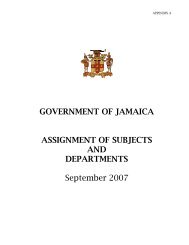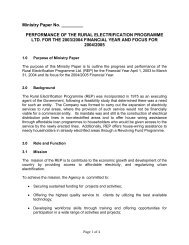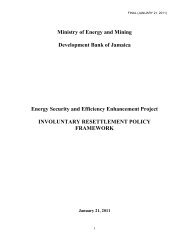Jamaica Biofuels Report - Ministry of Energy
Jamaica Biofuels Report - Ministry of Energy
Jamaica Biofuels Report - Ministry of Energy
Create successful ePaper yourself
Turn your PDF publications into a flip-book with our unique Google optimized e-Paper software.
spacing) for cattle, pigs and others. It can grow in combination with castor and leucena, and itmatches very well with apiculture for pollination. It flowers 3 to 5 times a year. It producescelluloses from its cultivation and is quite tolerant to drought. The produced oil also doesn’tcontain sulfur and has superior yield in ester, around 90%.The theoretical production is <strong>of</strong> 5 tonne <strong>of</strong> beans/ha, with 38% <strong>of</strong> oil content or 1,650 liter <strong>of</strong>oil /ha. The residual cake would be 3,200 kg/ha. The actual average in Brazil is half <strong>of</strong> this value,and although not all reports are reliable, the cost <strong>of</strong> production, which depends on hand laborfor harvesting, appears to be decreasing with time.• Experience in similar conditions to <strong>Jamaica</strong> as a feedstock for biodieselThe field experience in Brazil to date has not demonstrated the many advantages claimed forJatropha. One important issue is the wide variation in the genetic material showing that thiscrop is not completely domesticated. When grown commercially, in larger areas, widevariations occur in productivity. As yet there is inadequate information to draw conclusionsconcerning longer term potential.• How it compares to castor as an optionIf all the advocates’ reasons to plant jatropha are valid, the plant is potentially a betteralternative to castor. In any case, it can be an option for marginal lands, including those withsteep slopes, and trial plantings could be pursued in combination with castor in small hillyareas. As with castor, extensive field trails are needed over several years before deciding onintroduction at large commercial scale.Other• SunflowerThis crop will compete for land with all other crops. Perhaps it can be used as crop rotation withsugar cane between ratoon replacements.• Tropical sugar beetTropical sugar beet can be an option in very particular cases. Some tests are being conducted ininter-row systems, but there remain lots <strong>of</strong> gaps in knowledge to recommend it as an option for<strong>Jamaica</strong>. Sugar cane has much higher yield and seems a more appropriate “sugar” crop thansugar beet.2.4 Biomass as supplemental fuelTo maximize the benefit <strong>of</strong> high efficiency cogeneration at sugar mills and ethanol plants, thecogeneration plants should be designed to run year round. While the cane cutting and millingseason can be lengthened and some bagasse can be stored as means to reduce the time periodwhen supplemental fuel is required, there is still likely to be a period <strong>of</strong> several months whensupplemental fuel will be required.Biomass crops vary widely, and the Petroleum Corporation <strong>of</strong> <strong>Jamaica</strong> has conducted fuelwoodresearch jointly with sugar mills in the past and continues to work in this area today. <strong>Energy</strong>forests with eucalyptus could be an option as well as elephant grass and bamboo. In all cases23










